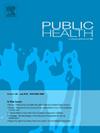心血管疾病患者流感疫苗接种意向的解释:扩展保护动机理论的应用
IF 3.9
3区 医学
Q1 PUBLIC, ENVIRONMENTAL & OCCUPATIONAL HEALTH
引用次数: 0
摘要
目的心血管疾病(CVD)患者易受流感病毒感染,流感疫苗接种可有效预防流感,但其吸收率仍然较低。本研究将基于延伸保护动机理论(extended protection motivation theory, PMT)探讨流感疫苗接种意愿的影响因素,并探讨不同疾病感知水平的患者在这一心理通路上是否存在差异。研究设计横断面研究。方法采用扩展PMT模型,该模型由原始构构(威胁与应对评估)和扩展构构(社会规范与信任)组成。基于此,构建了用于解释心血管疾病患者流感疫苗接种意向的模型。然后使用结构方程模型分别从总体人群、高疾病感知人群和低疾病感知人群中测试扩展理论。结果流感疫苗接种意愿与严重程度(β = 0.211)、易损性(β = 0.154)、应答效果(β = 0.243)、自我效能感(β = 0.154)、社会规范(β = 0.179)呈正相关,与应答成本(β = - 0.244)呈负相关。社会规范通过中介反应效能和自我效能对意向产生影响,而信息源信任通过中介自我效能对意向产生影响。延伸PMT在高疾病知觉患者中的解释效能高于低疾病知觉患者(75.1% vs 35.2%)。结论本研究发现,扩展后的PMT可用于解释心血管疾病患者对流感疫苗接种的意向。不同疾病感知水平的患者在路径上存在差异。建议对不同疾病感知水平的患者进行细分,并结合各亚组的理论模型制定干预策略。本文章由计算机程序翻译,如有差异,请以英文原文为准。
Explanation of intention toward influenza vaccination among cardiovascular disease patients: An application of the extended protection motivation theory
Objective
Patients with cardiovascular disease (CVD) are susceptible to influenza virus infection, and influenza vaccination is effective in preventing influenza, but its uptake remains low. This study will investigate the influencing factors affecting patients' intention to receive influenza vaccination based on the extended protection motivation theory (PMT) and explore whether there are differences in this psychological pathway among patients with different levels of illness perception.
Study design
Cross-sectional study.
Methods
In this study, the extended PMT model was used, which consists of the original construct (threat and coping assessment) and the extended construct (social norms and trust). Based on this, the model used to explain influenza vaccination intentions in CVD patients was constructed. Structural equation modelling was then used to test the extended theory from the overall population, the high-illness-perception and low-illness-perception populations, respectively.
Results
Intention toward influenza vaccination was positively correlated with severity (β = .211), vulnerability (β = .154), response efficacy (β = .243), self-efficacy (β = .154), and social norms (β = .179), while being negatively associated with response costs (β = −.244). Social norms influenced intention by mediating response efficacy and self-efficacy, while trust in information sources was mediated by self-efficacy. Extended PMT had higher interpretative efficacy in patients with high illness perception than in patients with low illness perception (75.1 % vs 35.2 %).
Conclusions
The study found that the extended PMT is appropriate for explaining the intention toward influenza vaccination of patients with CVD. Patients with different illness perception levels have differences in the paths. It is suggested that patients with different levels of illness perception be subdivided, and intervention strategies should be developed by considering the theoretical models of each subgroup.
求助全文
通过发布文献求助,成功后即可免费获取论文全文。
去求助
来源期刊

Public Health
医学-公共卫生、环境卫生与职业卫生
CiteScore
7.60
自引率
0.00%
发文量
280
审稿时长
37 days
期刊介绍:
Public Health is an international, multidisciplinary peer-reviewed journal. It publishes original papers, reviews and short reports on all aspects of the science, philosophy, and practice of public health.
 求助内容:
求助内容: 应助结果提醒方式:
应助结果提醒方式:


